How to Build a Survival Shelter

Being a “survivor” has captured the imagination of millions of TV watchers. But a survivor is much more than a TV fantasy. A survivor is someone prepared to live—and live as healthfully as possible—when life far from home doesn’t go exactly as planned.
Being prepared to survive in the outdoors starts with knowing what to be prepared for. You can live days without water and weeks without food. People who don’t survive in the outdoors most often die from losing their body heat, not necessarily from starvation or dehydration. You need to be able to start a fire. And perhaps most importantly, you need to be able to build a shelter to stave off wind, rain and snow, and to keep your body heat trapped where it belongs: near your body.
Here are the keys to taking shelter in the wilderness:
DRESS WISELY
Your first line of defense against the elements is the “shelter” you choose to wear. If you wear layers of synthetic material or wool, and carry a shell of windproof, waterproof material, you are ready for anything. You’ll trap your body heat instead of expending it on the outside world.
THE RIGHT SPOT
Choosing the best place to build a survival shelter is important. It should be in the driest spot you can find. Nothing sucks out body heat faster than wetness. If it isn’t too cold, build a shelter on high ground. Breezes will help keep the bugs away, and you’ll be easier to see if a search party passes nearby. If a cold wind is blowing, choose a spot sheltered by trees. But don’t build in the bottom of deep valleys or ravines where cold air settles at night.
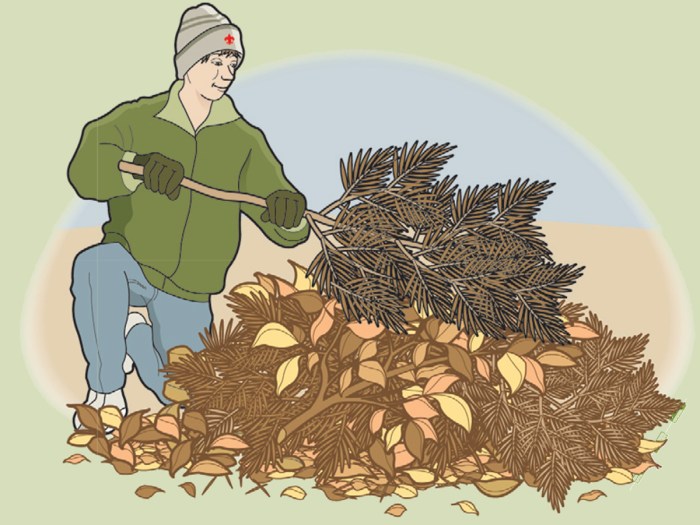
THE COCOON
If it’s almost dark and you can hurriedly collect dry debris (leaves, pine needles, bark) from the forest floor, make a pile two or three feet high and longer than you are tall. When you burrow into the pile, you are in a natural sleeping bag that protects against heat loss.
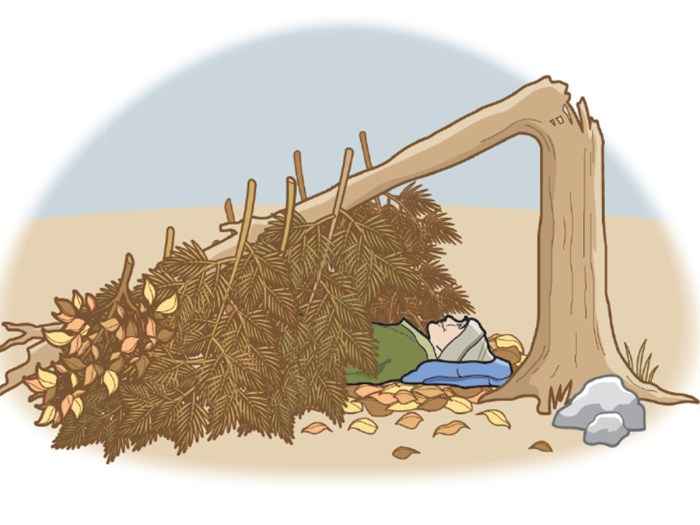
THE FALLEN TREE
The simplest shelter is a fallen tree that has enough room under it for you to crawl in. Lean branches against the windward side of the tree (so the wind is blowing into it and not against it) to make a wall. Make the wall thick enough to keep out wind. If you can build a fire on the open side of your shelter, the heat will help keep you warm.
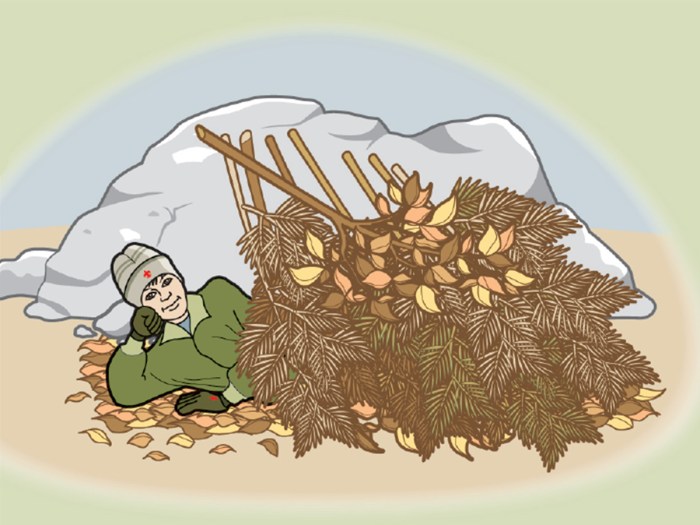
THE LEAN-TO
If you find a fallen tree without enough room under it, or a rock or a small overhang, you can build a simple lean-to. Start by leaning fallen limbs against the object, such as the top edge of an overhang, to create a wall. Lean the limbs at an angle to help shield rain. Cover the leaning limbs with leaves, boughs, pine needles, bark or whatever the forest offers. When you have built a thick wall, you can crawl underneath into your shelter. Remember to make your shelter no bigger than you need to fit you and anybody else with you. The bigger the space, the harder it is to keep warm.
You can also build a lean-to by placing one end of a long stick across a low limb of a tree and propping up the other end of the stick with two more sticks. Tie the ends of the sticks together with your boot laces or belt. Lean more sticks against the horizontal stick. Then pile leaves and other forest debris against the leaning sticks until you have a wall. Once again, a fire on the open side of the lean-to will add much heat to your “room.”
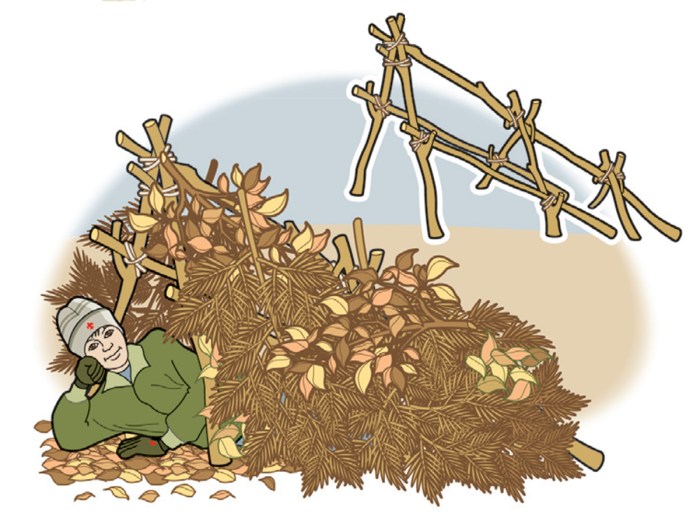
THE A-FRAME
If you can’t make a lean-to, you can make an A-frame shelter. You’ll need two sticks four or five feet long and one stick 10 to 12 feet long. Prop the two shorter sticks up in the shape of the letter A. Prop the longer stick up at the top of the A. Tie the three sticks together where they meet. The three sticks will be in the shape of an A-frame tent with one end collapsed against the ground. Now prop up more sticks against the longer stick, and pile forest debris against the sticks until you have an insulated shelter open at the high end.
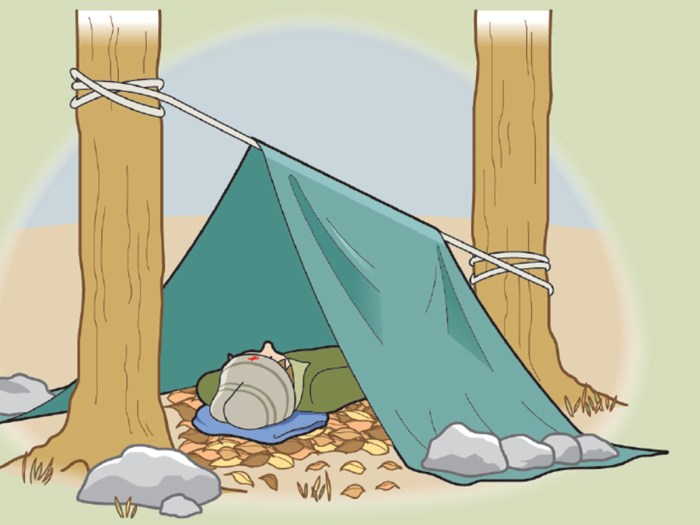
A TARP
When you have a tarp, sheet of plastic or Space Blanket with you, and some rope or cord, tie a line between two trees. Tie it low to the ground with just enough room for you to lie beneath. Stretch the tarp over the line. Place large rocks or logs on the ends of the tarp to hold it in place with the edges close to the ground. If it’s snowing, tie the line off higher on the trees. Steeper walls will shed snow better. Now you have an emergency tent.
YOUR BED
Your shelter is not complete until you have made a bed to lie in. Dry leaves work well. Make your bed a little bigger than the space your body covers and at least eight inches thick. When you snuggle into it, you are ready for the unexpected night out.
BAD PLACES TO BUILD A SHELTER
1. Anywhere the ground is damp.
2. On mountaintops and open ridges where you are exposed to cold wind.
3. In the bottom of narrow valleys where cold collects at night.
4. Ravines or washes where water runs when it rains.
This is awesome! The fallen tree idea is pretty creative.
relly good tips
cool things
this is helpful
im like extravagant
lol
what year was this website made?
oh jeez rick
good info definitely helps with my assignment
good work billy!
what if a land shark eats me?
It is cool! continue doing your shelter ideas! 😀
I don’t think that was a shelter idea :/
Cool
Thx
Cool
This information is great!
I think its boring i’m with asdfghljk but I also think its cool because trees give me give all of us oxygen.
This was really useful. I loved 😀
It was really healpful
what if a hurricane comes and takes all your food and water and it takes your I phone?
what if the earth is flatter than i am?
Then your food,water, and iphone goes away
Good job on the site
it is awsome
good if one is in a pinch such as if their stranded or homeless in a rural area. tarps are so useful for many things.
the best info ever
i love it
Great info!
cool
I am a person doing a assingment
can’t find date published
what happen when the tree fall on you
How about a conical lean to? Like half a stick teepee against a small tree?
It’s verry good idea for everybody go to the bush.
send me more thanks
cool facts love them
Cool
i like it
The sarcastic face on the guy in the illustrations is killing me here bros. The author is like, “build a shelter under a broken tree!” and this guy is like 🐵
At least I’m not the only one who thought “but that’s going to fall…” when they saw the dude under the tree
What is the smartest hut to build aside from the tarp one?
What is the most sturdy and warm hut?
not bad
Great Page! I could use this a lot!
Great ideas! love this page
This is such a helpful source. Used it for writing prompt I absolutely loved it. Thank you
If a tree falls on you then you don’t have to worry about finding food. You’ll be it
yeah, what if the broken tree falls on you, thats where the nickname “widow maker” comes from
wow could survivers realy build, makea house and still survive
its cool
what will happen’s if there’s a tornado?
or if you are very hungry?
I LOVE THIS SITE SO MUCH.
Just look for ShepherdSurvives page. You will find there the best survival instructions.
What if the broken tree falls on you.
What if the broken tree falls on you.
lol
LoL, I rather do something like EpicFace
it won’t. it knows where to fall.
boring
I love it
like the lean to